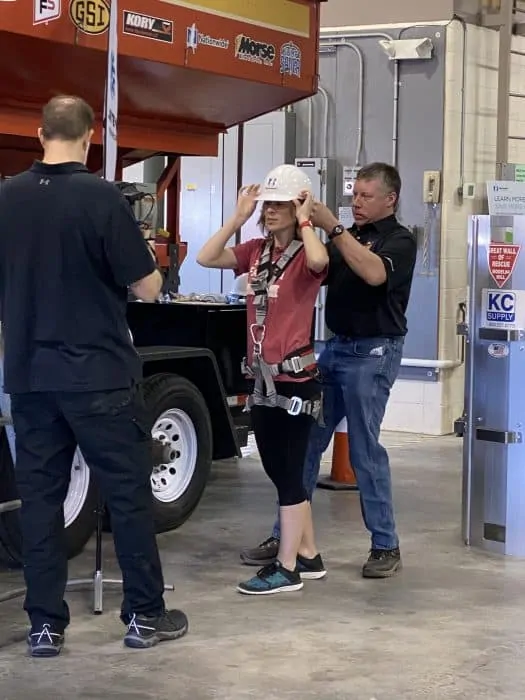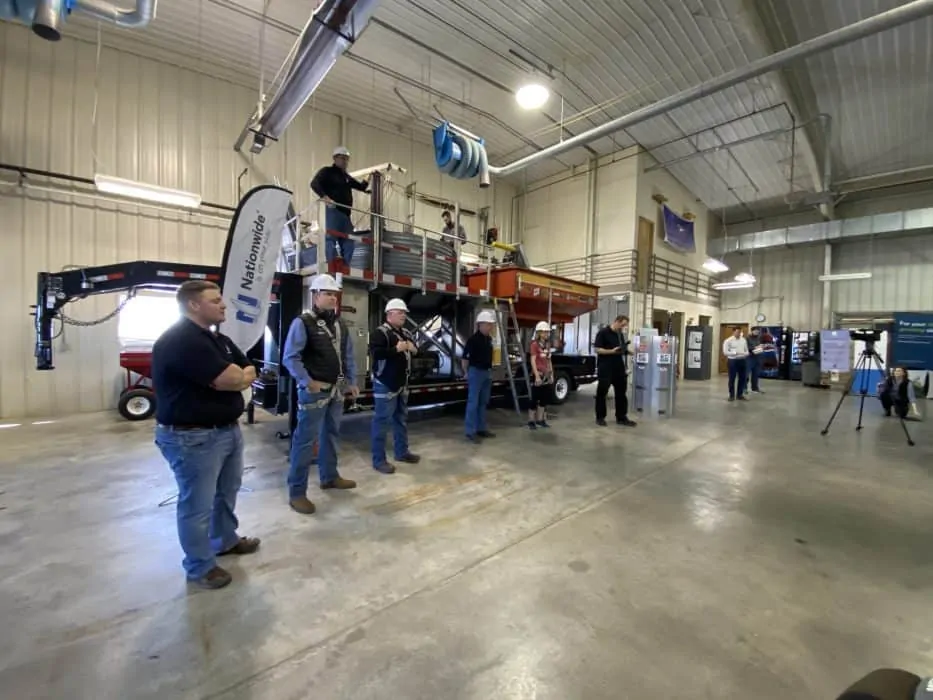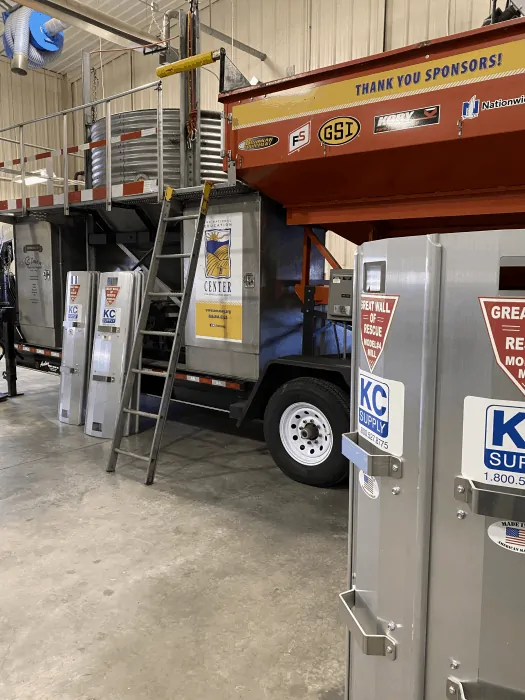National Farm Safety and Health Week is the perfect time each year to stop and reflect on your farm activities. How you can adjust to make all of your on-farm activities safer and healthier for everyone all year long? Just a little focus on how to mitigate risks, including grain bin safety, on the farm can keep everyone safer and healthier. In this blog I am going to focus in on Grain Bin Safety and will recount my experience being “trapped” in a bin full of corn.
Grain Bin Accidents Often Lead to Death
Confined space entrapment has resulted in an injury, fatality, or required emergency extrication 2117* times over the past 50 years. Sixty percent of these were fatal wand 71%* involving grain storage and handling facilities. I’ve heard it said before and I’ll repeat it a million more times, not one life ever needs to be lost due to grain entrapment. *Purdue University
A Commitment to Safety
Recently, my friends at Nationwide asked if I would be interested in participating in a grain bin rescue operation during Grain Bin Safety Week. I have learned in our partnership with Nationwide that they are seriously committed to making sure farmers are operating safely. Focusing on farm safety is also very important to me so I didn’t blink at saying yes. When I came home and told my husband what I had signed up for his face basically went white. He said, you are going to do WHAT? I went on to explain it would be a demonstration and that I would be hooked up to a safety harness with plenty of knowledgeable people standing by. He still wasn’t too sure, but I knew my friends at Nationwide had my back!

Heading into the Bin
Next up I headed to the National Education Center for Agricultural Safety (NECAS) for the demonstration. As the room filled with spectators, I was more than a little nervous. After a brief conversation with the NECAS team, I put on the safety harness and climbed up onto the bin. This particular bin was one of a few training units that NECAS has for doing rescue demonstrations. It is smaller than a regular bin on the farm, but no less daunting when you are about to be sunk into it. With attendants ready and waiting, I climbed up over the edge and stood in the center of the corn.
Sinking into Grain
Once I was standing on the corn in the bin, they turned the auger below on. Almost immediately I was sunk up to my calves and couldn’t move my feet at all. Within seconds I was up to my waist in corn and completely stuck. Now, you might think, why couldn’t they just pull me out. Well, the answer is pressure. Pulling a person out with that much pressure on them could be fatal. The crew of helpers then set right to work building in the rescue tube panels around me, one by one. About the same time I started to really notice the burning in my nose and eyes from grain dust. The rescue tube used that day was from KC Supply but there are many available on the market.
Getting Rescued: Fear, Frustration and Intensity
Next the team put an auger down into the grain and used a cordless drill to power the auger. The auger then pulled grain up and out of the tube. In about 10 minus my legs freed up enough to wiggle my toes. They pulled out a bit more grain and then I could move one of my legs up and out. I can’t express the feeling of relief that washed over me when I was finally out of the grain. While I was out of the grain, just those 10 minutes left visible dents in my legs from the intense pressure from the corn. While my experience was definitely unnerving, I can’t imagine the fear, frustration and intensity that comes with a real entrapment. The average grain bin rescue time is 3.5 hrs from when the fire department gets on scene to when the victim is rescued.

PS…have you ever heard of SILO the Film? If not you need to check it out. We did a podcast with Sam Goldberg, the Producer – you can listen in here. Think the intensity of Twister (another rural based movie I love) meets the farm. I promise it is worth your time!
Zero Entry Mentality
My experience being buried in corn was just a demonstration with all of the safety measures in place to make sure I got out safely. In talking to Dan Neenan, the Director of NECAS, I learned that the very best option is not ever need to be rescued. Ideally all farmers should focus on a zero entry mentality. This means always asking, “do I have to get into the bin” before even entering. If you don’t enter the bin, you can’t get trapped. Simple, right? Well, we all know that it’s not always as simple as that. Grain in a bin is money in a bin and if it’s not flowing out properly, that is where the trouble can begin.

Grain that is wet when it goes into the bin is the most common cause of grain bin accidents. Wet corn can clump up while inside the bin and when that happens, someone has to enter the bin to break it up. Then, while in the bin, grain can shift under the person, trapping and possibly suffocating them.
5 Steps to Staying Safe When Entering a Grain Bin
- Zero Entry Mentality – do you have to go into the bin? Avoiding entry in the bin is the safest option!
- If you must enter, wear a full body harness for safety. I wore one during my rescue and it helped me feel more secure. Being secure will only help the your ability to safely and calmly help someone else.
- There always needs to be two people in a rescue. One person is strictly the attendant to monitor the person doing the rescue.
- Lock out and tag out the power source to the auger. If you are in the bin with the auger on you can be submerged to your waist in 10-15 seconds and fully submerged in 30 seconds. I can attest that this happens quicker than you can imagine! Before going in, shut the circuit breaker off, then make sure it is locked off so nobody can inadvertently turn the power back on.
- Check the oxygen content to make sure it is at least 19.5%. This is important to make sure that nobody operating the rescue passes out! Until I was sunk into the bin I didn’t completely understand this. The grain inside the bin created so much dust that it quickly became hard to breathe!
Advocating for Grain Bin Safety
Nationwide, the number one farm and ranch insurer in the country, recognized a need and started a Grain Bin Safety advocacy program in 2014. Their goal is to raise awareness and educate about the hazards of entering a grain structure. They also aim to help manage the risk and provide resources to the communities they serve. Nationwide, along with KC Supply, Corteva, and NECAS as sponsors, has given away over 100 grain bin safety tubes and training to rural communities in over 25 states.

How To Win a Grain Bin Rescue Tube
A rescue is ideally performed by a local fire department with trained professionals. Nationwide offers a program to nominate your local fire department to win a Grain Bin Rescue Tube and the training that goes along with it. To nominate a Fire Department for the program, go to www.grainbinsafetyweek.com and complete the nomination form. Nationwide suggests entering as much narrative as possible to make a strong case for your community. Additionally, the suggest collaborating with other fire departments on the nominations. You can also submit more than one nomination. We all know the squeaky wheel gets the grease so sign up, make a strong case, and sign up again!
Farm Safety All Year Long
https://www.mynsightonline.com/nominate-your-fire-department-form?_ga=2.140495605.718817109.1600712775-1451887471.1595447852For more resources and to nominate your community fire department for a grain bin rescue tube and the training that goes along with it, please visit www.grainbinsafetyweek.com. Being safe on the farm isn’t just for this week, or next, but it’s something we all can focus on all year long. It just takes a little time to be informed and can mean the difference between life or death. Again, nominate your fire department at grainbinsafetyweek.com and check out other farm safety resources at NECAS.
Want to learn about ways that you can manage your risk with the farm vehicles you own or operate? Check out this program by Nationwide too! It’s worth a call to your local Nationwide agent to see what they can offer and to help you get on the road to being safer and healthier on the farm!
Have you checked out our other Everybody Eats stories yet? Everybody Eats and all food starts at the farm. Join FarmHer as we explore all parts and pieces of the food supply chain, and how farmers make sure Everybody Eats.



You made a good point that there are a lot of risks involved when safety is not prioritized when handling grain. I’d like to know more about grain handling systems because there are times when I wonder about having my own farm when I settle down someday. I’m sure that it would be a modest but fulfilling goal to have.